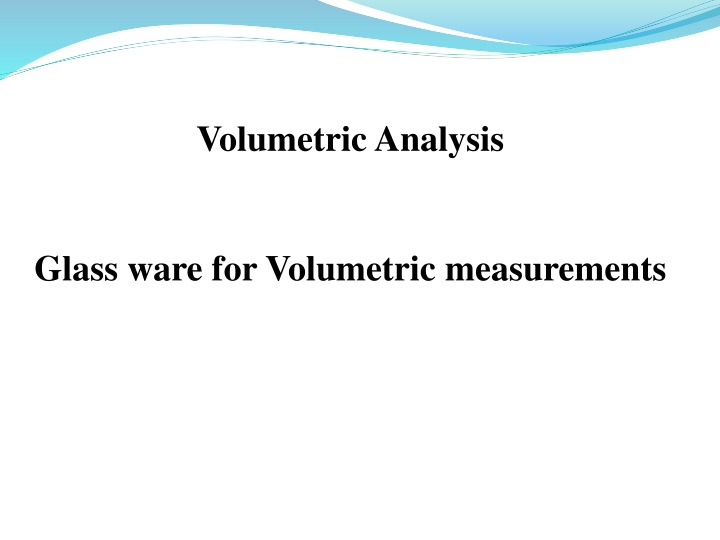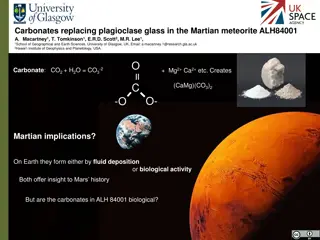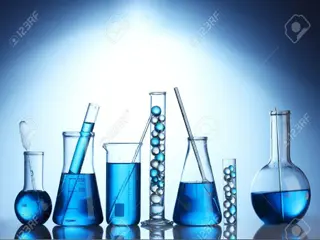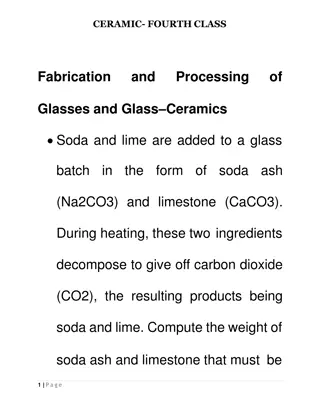Volumetric Analysis Glass ware for Volumetric measurements
In analytical chemistry, volumetric analysis involves accurate measurements to determine the amount of substances in a sample. It relies on titration, where a standard solution is added to the analyte until the equivalence point is reached. The process includes using glassware such as beakers, flasks, pipettes, and burettes for precise measurements. Qualitative and quantitative analyses play a crucial role in identifying elements and compounds and assessing their quantities, respectively. Titration involves the titrant reacting with the titrand until the equivalence point is achieved, indicating equal amounts of reagents. Indicators help detect endpoint changes in color, signaling chemical equivalence.
Download Presentation

Please find below an Image/Link to download the presentation.
The content on the website is provided AS IS for your information and personal use only. It may not be sold, licensed, or shared on other websites without obtaining consent from the author.If you encounter any issues during the download, it is possible that the publisher has removed the file from their server.
You are allowed to download the files provided on this website for personal or commercial use, subject to the condition that they are used lawfully. All files are the property of their respective owners.
The content on the website is provided AS IS for your information and personal use only. It may not be sold, licensed, or shared on other websites without obtaining consent from the author.
E N D
Presentation Transcript
Volumetric Analysis Glass ware for Volumetric measurements
Funnel Beaker Conical flask Volumetric flask
Pipette Cylinder Burete
Clamp Watch glass Stirrer Stand Reagent bottle Washing bottle
Analytical chemistry:Is applied throughout industry, medicine and all the sciences it is classified to:
Analytical chemistry Quantitative Analysis Qualitative Analysis Instrumental method Chemical method Gravimetric analysis Volumetric analysis Thermal analysis Electroanalytical methods Optical methods
Qualitative analysis: reveals the identity of the elements and compounds in a sample. Quantitative analysis: indicates the amount of each substance in a sample. Volumetric analysis: It is based on accurate measurements of final volume of a standard reagent solution of known concentration needed to react with the analyte in a known volume of sample.
Titration: is a process in which a standard reagent (known conc.) is added to a solution of an analyte until the reaction between the analyte and reagent is attained equivalence point. Titrant (Standard solution) Titrand (Analyte) Physical change
Equivalence point: Is the point in a titration when the amount of added standard reagent is exactly equivalent to the amount of analyte. At equivalent point: (no. of eq.wt titrant) = (no. of eq.wt. titrand) (N = no.of eq.wt / V) (N V)Standard = (N V)Analyte
End point: Is the point in a titration when a physical change occurs that is associated with the condition of chemical equivalence. Indicators: Chemical compounds undergo change in colour during titration which indicates the equivalence point. Acid-base indicators are generally weak organic acids or bases which, upon dissociation or association, undergo internal structural changes at a specific range of pH that give rise to alterations in color. We can symbolize the typical reaction of an acid-base indicator as follows:
For the first indicator (1), HIn will be the major constituent in strongly acidic solutions and will be responsible for the "acid color" of the indicator, whereas In- will represent its "base color" For the second indicator (2), the species In will predominate in basic solutions and thus be responsible for the base color , whereas InH+will constitute the acid color .
Color in Color in pH Indicator acidic basic range medium medium Thymol blue Red Yellow 1.2 3.0 Methyl orange Red Yellow 3.1 4.4 Methyl red Red Yellow 4.2 6.2 Phenolphthalein Colorless Pink 8.3 10
Primary standards It is a highly purified compound that serves as a reference material in volumetric (titrimetric) method.
Important requirements for a primary standard are the following: 1. High purity. 2. High stability. 3. It has a large molecular weight to minimize the relative error during weighing the substance. 4. It must be not hygroscopic. 5. Low cost. 6. The substance must be not poison. 7. Soluble in a solvent (especially water).
Secondary standard: Is a compound whose purity has been established by chemical analysis and that serves as the reference material for a titrimetric method of analysis. Standard solution: Is a reagent of exactly known concentration that is used in a titrimetric analysis, and it's prepared either from primary standard material or its concentration determined by standardization with primary standard material.
For use in titrimetric analysis a reaction must fulfill the following conditions: 1. There must be a simple reaction which can be expressed by a chemical equation. The substance to be determined should react completely with the reagent. 2. The reaction should be relatively fast. (Most ionic reactions satisfy this condition). 3. There must be an alteration in some physical or chemical property of the solution at equivalence point. 4. An indicator should be available which, by a change in physical properties (color or formation of a precipitate), should sharply define the end point of the reaction.
Types of titrations according to the chemical reaction 1-Neutralization titration (Acid-base titration). NaOH + HCl NaCl + H2O 2-Precipitation titration. AgNO3 + NaCl AgCl + NaNO3 3-Reduction-oxidation titration (Redox titration). 5Fe2+ + Mn7+ + 8H+ 5Fe3+ + Mn2+ + 4H2O 4-Complexation titration. Hg2+ + 4I- HgI42-
1- Neutralization titration (Acid-base titration) These include the titration of free bases with a standard acid, and the titration of free acids with a standard base. These reactions involve the combination of hydrogen and hydroxide ions to form water. H+ + OH- H2O Example: NaOH + HCl NaCl + H2O Na2CO3 + 2HCl 2NaCl + CO2 + H2O






















